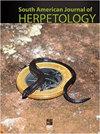Tick Infection of Caiman crocodilus fuscus at the Hidroprado Hydroelectric Dam in Colombia: New Records, Parasite Prevalence, and Blood Loss Rate
IF 0.7
4区 生物学
Q4 ZOOLOGY
引用次数: 3
Abstract
Abstract. The main goal of this research was to identify the hard ticks (Acari: Ixodidae) found in 10 individuals of spectacled caiman (Caiman crocodilus fuscus) from 349 individuals captured at the Hidroprado hydroelectric dam in the Department of Tolima, Colombia. Parasite prevalence was 2.9%. A total of 40 ticks were collected and two species identified: Amblyomma dissimile (n = 39) and Rhipicephalus sanguineus (n = 1). This is the second record of A. dissimile in C. crocodilus in Colombia and the first record of R. sanguineus in crocodilians. The natural infection of C. c. fuscus by A. dissimile establishes this species as a host in the life cycle of this tick. Similarly, parasitism by R. sanguineus indicates C. c. fuscus as a potential host for this tick, which is important since it is associated with domestic animals and has a high potential for transmission of zoonotic diseases. Our results highlight the parasitic relationship between ticks and one of the most resistant wild vertebrates: caimans. The prevalence, although not high, establishes the potential of ticks to parasitize different species and to be a vector of diseases for new groups of hosts.哥伦比亚Hidroprado水电站凯门鳄的蜱虫感染:新记录、寄生虫流行率和失血率
摘要这项研究的主要目标是识别在哥伦比亚托利马省Hidroprado水电站大坝捕获的349只眼镜凯门鳄(caiman鳄fuscus)中的10只个体中发现的硬蜱(阿卡里:硬蜱科)。寄生虫的流行率为2.9%。共收集了40只蜱,鉴定出两个物种:不同的Amblyomma(n=39)和血红Rhipipipcephalus sangeeus(n=1)。这是A.disile在哥伦比亚的C.crocrocus中的第二个记录,也是R.sangeus在鳄鱼纲中的第一个记录。C.C.fuscus被A.diffile自然感染,使该物种成为该蜱生命周期中的宿主。类似地,红血蜱的寄生表明C.C.fuscus是这种蜱的潜在宿主,这一点很重要,因为它与家畜有关,并且具有很高的人畜共患疾病传播潜力。我们的研究结果强调了蜱虫与最具抵抗力的野生脊椎动物之一凯门鳄之间的寄生关系。这种流行率虽然不高,但表明蜱虫有可能寄生在不同物种中,并成为新宿主群体的疾病媒介。
本文章由计算机程序翻译,如有差异,请以英文原文为准。
求助全文
约1分钟内获得全文
求助全文
来源期刊
CiteScore
1.50
自引率
0.00%
发文量
10
期刊介绍:
The South American Journal of Herpetology (SAJH) is an international journal published by the Brazilian Society of Herpetology that aims to provide an effective medium of communication for the international herpetological community. SAJH publishes peer-reviewed original contributions on all subjects related to the biology of amphibians and reptiles, including descriptive, comparative, inferential, and experimental studies and taxa from anywhere in the world, as well as theoretical studies that explore principles and methods.

 求助内容:
求助内容: 应助结果提醒方式:
应助结果提醒方式:


